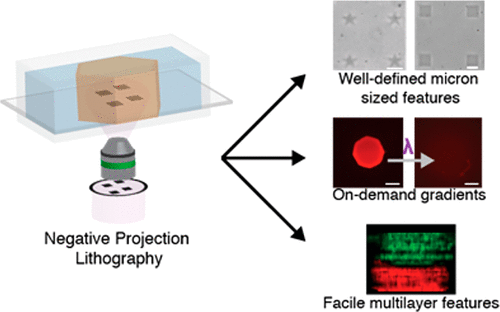当前位置:
X-MOL 学术
›
ACS Biomater. Sci. Eng.
›
论文详情
Our official English website, www.x-mol.net, welcomes your feedback! (Note: you will need to create a separate account there.)
Fabrication of Functional Biomaterial Microstructures by in Situ Photopolymerization and Photodegradation.
ACS Biomaterials Science & Engineering ( IF 5.8 ) Pub Date : 2018-07-05 , DOI: 10.1021/acsbiomaterials.8b00350 Paige J LeValley 1 , Ben Noren 1 , Prathamesh M Kharkar 2 , April M Kloxin 2 , Jesse C Gatlin 3 , John S Oakey 1
ACS Biomaterials Science & Engineering ( IF 5.8 ) Pub Date : 2018-07-05 , DOI: 10.1021/acsbiomaterials.8b00350 Paige J LeValley 1 , Ben Noren 1 , Prathamesh M Kharkar 2 , April M Kloxin 2 , Jesse C Gatlin 3 , John S Oakey 1
Affiliation

|
The in situ fabrication of poly(ethylene glycol) diacrylate (PEGDA) hydrogel microstructures within poly(dimethylsiloxane) (PDMS)-based microfluidic networks is a versatile technique that has enabled unique applications in biosensing, medical diagnostics, and the fundamental life sciences. Hydrogel structures have previously been patterned by the lithographic photopolymerization of PEGDA hydrogel forming solutions, a process that is confounded by oxygen-permeable PDMS. Here, we introduce an alternate PEG patterning technique that relies upon the optical sculpting of features by patterned light-induced erosion of photodegradable PEGDA deemed negative projection lithography. We quantitatively compared the hydrogel micropatterning fidelity of negative projection lithography to positive projection lithography, using traditional PEGDA photopolymerization, within PDMS devices. We found that the channel depth, the local oxygen atmosphere, and the UV exposure time dictated the size and resolution of hydrogel features formed using positive projection lithography. In contrast, negative projection lithography was observed to deliver high-resolution functional features with dimensions on the order of single micrometers enabled by its facilely controlled mechanism of feature formation that is insensitive to oxygen. Next, the utility of photodegradable PEGDA was further assessed by encapsulating or conjugating bioactive molecules within photodegradable PEG matrixes to provide a route to the formation of complex and dynamically reconfigurable chemical microenvironments. Finally, we demonstrated that negative projection lithography enabled photopatterning of multilayered microscale objects without the need for precise mask alignment. The described approach for photopatterning high-resolution photolabile hydrogel microstructures directly within PDMS microchannels could enable novel microsystems of increasing complexity and sophistication for a variety of clinical and biological applications.
中文翻译:

通过原位光聚合和光降解制备功能性生物材料微结构。
在基于聚二甲基硅氧烷(PDMS)的微流体网络中原位制造聚乙二醇二丙烯酸酯(PEGDA)水凝胶微结构是一种通用技术,已在生物传感,医学诊断和基础生命科学中得到了独特的应用。先前已经通过PEGDA水凝胶形成溶液的光刻光聚合对水凝胶结构进行了图案化,该过程被透氧PDMS所混淆。在这里,我们介绍了另一种PEG图案化技术,该技术依赖于通过图案化的光诱导侵蚀可降解PEGDA的图案化光诱导腐蚀而形成的负投影光刻技术,该技术是基于特征的光学雕刻。我们定量比较了负投影光刻与正投影光刻的水凝胶微图案保真度,在PDMS设备中使用传统的PEGDA光聚合。我们发现通道深度,局部氧气气氛和紫外线暴露时间决定了使用正投影光刻技术形成的水凝胶特征的尺寸和分辨率。相反,观察到负投影光刻技术可通过其对氧气不敏感的易于控制的特征形成机制来提供尺寸为单个微米级的高分辨率功能特征。接下来,通过将生物活性分子封装或缀合在可光降解PEG基质中,进一步评估可光降解PEGDA的用途,以提供形成复杂且可动态重构的化学微环境的途径。最后,我们证明了负投影光刻技术可以对多层微尺度物体进行光图案化,而无需精确的掩模对准。直接在PDMS微通道内对高分辨率的光不稳定水凝胶微结构进行光图案化的方法可以使新型微系统的复杂性和复杂性不断提高,可用于各种临床和生物学应用。
更新日期:2018-07-05
中文翻译:

通过原位光聚合和光降解制备功能性生物材料微结构。
在基于聚二甲基硅氧烷(PDMS)的微流体网络中原位制造聚乙二醇二丙烯酸酯(PEGDA)水凝胶微结构是一种通用技术,已在生物传感,医学诊断和基础生命科学中得到了独特的应用。先前已经通过PEGDA水凝胶形成溶液的光刻光聚合对水凝胶结构进行了图案化,该过程被透氧PDMS所混淆。在这里,我们介绍了另一种PEG图案化技术,该技术依赖于通过图案化的光诱导侵蚀可降解PEGDA的图案化光诱导腐蚀而形成的负投影光刻技术,该技术是基于特征的光学雕刻。我们定量比较了负投影光刻与正投影光刻的水凝胶微图案保真度,在PDMS设备中使用传统的PEGDA光聚合。我们发现通道深度,局部氧气气氛和紫外线暴露时间决定了使用正投影光刻技术形成的水凝胶特征的尺寸和分辨率。相反,观察到负投影光刻技术可通过其对氧气不敏感的易于控制的特征形成机制来提供尺寸为单个微米级的高分辨率功能特征。接下来,通过将生物活性分子封装或缀合在可光降解PEG基质中,进一步评估可光降解PEGDA的用途,以提供形成复杂且可动态重构的化学微环境的途径。最后,我们证明了负投影光刻技术可以对多层微尺度物体进行光图案化,而无需精确的掩模对准。直接在PDMS微通道内对高分辨率的光不稳定水凝胶微结构进行光图案化的方法可以使新型微系统的复杂性和复杂性不断提高,可用于各种临床和生物学应用。


























 京公网安备 11010802027423号
京公网安备 11010802027423号